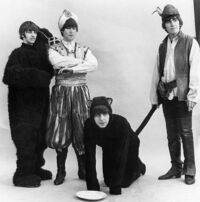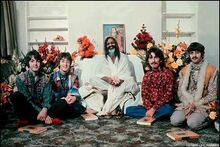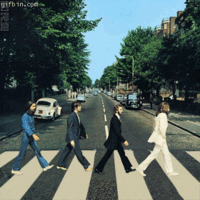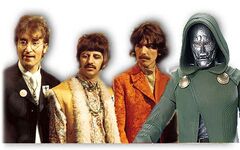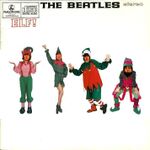The Beatles
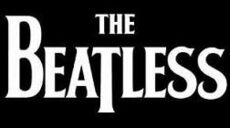
The Beatles were an English pop-rock band and one of the most famous comedy routines of all time. Their classic lineup consisted of the God of music, Sir Richard Starkey, plus some dudes named John, Paul, and George who were his sessionmen. They released many successful pop songs throughout the 1960s; and if you can remember the '60s, you're too old to be on the Internet.
Lots of girls would throw their knickers at them while they performed on-stage, yet nobody knows how they managed to get them off in the crowd. The group was quite successful, though musically they were in the shadows of Herman's Hermits and the Dave Clark Five. They are often seen as an Oasis tribute band, capturing similar looks to that of Noel Gallagher and Liam Gallagher.
Background
Our story begins with two young art students John Lennon and Paul McCartney on the top deck of a Liverpool bus. The two lads found they were united in their love of skiffle, a crude musical style devised by English songster Donnie Lonegan, and named after a Liverpool night out.
The two were sharing a Woodbine when somebody spoke, and they went into a dream. It was the morose, juvenile George Harrison, distinguished for his ability to play something on guitar that sounded like The Shadows. The two recognized someone they could pick on, and the dream of forming a top pop band was born. Quickly, they recruited good-looking drummer Pete Best and a shady bassist, Stu Sutcliffe, to round out their lineup.
Before settling on the name that made them famous, the five performed in many of their front rooms under a variety of names, including: The Clay Men, Johnny and the Moptops, The Silver Bullets, The Big Three, The Fab Four, and The Slaughterhouse Five. But their break came when, by fantastic chance, they won a residency at the local Cotton Club, owned by Pete's mum. Their radio broadcasts rocked Liverpool, and they immediately embarked on a major tour of a street in Hamburger, Germany.
There it was that, surrounded by sailors and prostitutes, The Beatles looked on in shock as a drunken Stu Sutcliffe appeared naked on stage to make his epoch-making speech, latter dubbed 'Ich bin ein Hamburger' by the locals. Playing fourteen-hour shifts whilst sweating heavily, the band fast became a killer rhythm section that smelled. Sometimes, they would perform for days on end simply because their confused teen hormones convinced them that the footsweat that glued them to the stage was comfortable.
As the weeks went by and their money slowly faded away, The Beatles melted into their audience, even participating in their own bar fights for them. When they finally sobered up, they found that Ringo Starr had replaced Pete Worst as their drummer. Inspired by Chuck Berry and Buddy Holly, the band began to experiment with writing songs that copied their heroes.
Back in Liverpool, furniture salesman Brian Epstein was impressed by a young fan who entered his premises demanding the German record My Bunny by local heroes 'The Bootless'. "This is a furniture shop, you idiot!" quipped Brian. Within hours he was at the Cotton Club, assuring the young hopefuls that their total sales of 10,000 guaranteed fame and that he would be their manager.
1962–66: "Red" years, Beatlemania, teenybopper phase
First singles, Please Please Me, and Without the Beatles
In 1962, Epstein signed The Beatles onto Parlorphone Records. Their first single, "Do Me, Love", earned them a disappointing #18, or #17 depending on who you pay, in the Barmy British 100 charts, as well as a £50 obscenity fine. This was followed shortly by their second single, "Please Please Me", a thinly disguised plea for consensual favours that was an instant #1 chart-topper in Britain — or #2, depending on who pays you.
In 1963, The Beatles recorded their first album, Please Please Me. It contained all of the songs they recorded that weren't released as singles, leading to poor reception and the general vibe of "every song sounds the same." Two notable exceptions to this are the songs "I Saw Her Standing There" and "Twist and Shout", which according to Lennon and McCartney are about the same encounter with an attractive woman in a club.
Later in 1963, The Beatless recorded a second album, Without the Beatles. This was the same as the first, except different songs, obviously, and the piano was mixed up a bit. The band showed its versatility in its command of popular idioms in successive singles thus; swing beat, twist beat, twist beat, swing beat, twist beat, swing beat, twist beat. At this point, Lennon, who had always thought The Beatles recorded his songs too fast, started doing them slower. The accompanying single, "I Wanna Steal Your Man", went to #1 in the United States (or, depending on who pays you, #3), pursued by its subtly lyrical predecessor, "She Loves You (But I'll Get You)". This was the beginning of The Beatles hitting America.
Due to business interests, Capitol Records released the band's albums completely re-configured in America. Without the Beatles was released as Meet the Mopheads, and Please Please Me was released as The Beatles Second Album, and as Maybe the Third (We Don't Know) in some select states. At the time, fans didn't know any better, but when they did, they were quite upset.
In February 1964, The Beatles appeared on The Ed Sullivan Show and rocked the history books, becoming the most-watched band on television of the 1960s. That night, The Ed Sullivan Show also had the most viewers of its entire run, with guesstimates of around ten or twelve people.
A Hard Day's Night, Beatles for Sail, and Help!
Later that year, film director Richard Lester asked to make a movie about the band based on one of their sketches. This movie was A Hard Day's Night, about a 25-hours a day, eight days a week account of being in a band (despite the movie's 1.5 hour runtime), with the Fab Four getting into hijinks running away from crazed fans. The boys did it as Lester had appeared on "The Ying Tong Song" with The Goons — and also because he knew Pete's mum. The soundtrack album was notably their first to have all Lennon/McCartney originals and no cover songs, with John's tough sardonicism being complemented by Paul's soaring melodic gift. The Beatles were now film stars; Lennon found he could be nasty to everyone and they liked it.
Their next album, called Beatles for Sail, was weaker if inventive with sea shanties and some early attempts at folk rock. Lennon identified the album as the turning-point when his songwriting started getting real, after he did weed with Bob Dylan. He'd gotten a folkie guitar and done the song "I'm a Loser", which was a cry from the heart. Stung by the idea that The Kinks, Stones, and Yardbirds were heavier than his Moondogs, Johnny had started to slow it down and grunge it up a bit. However critics were blinded to this artistic growth, as the rest of the album consisted of ill-rehearsed reject singles, a few half-baked 12-bars, and an afternoonsworth of Hamburg cover-versions (a step back from the all-original tracklist on Hard Day's Night).
By this point, The Beatles were in a hectic lifestyle and had to expand their usual twenty-five hours into twenty-seven hours, without sleeping. In order to do this, they had to clone themselves to go on a world tour. They never got around to cloning Ringo so they used a completely different drummer. This annoyed Imelda Magoo and her shoes so they went home, especially George. So we don't talk about Beatles for Sale: 20% Discount, and nobody is really sure if the right tracks were on it.
In 1965, Richard Lester contacted them again to do the movie Help!, a twenty-four hour account of the struggles of being in a band. The film was simply too campy, but the album was good on both sides. Still somewhat lightweight, and still sporting a couple of cover-versions, but still only one Ringo song! Lennon also did another heartfelt Dylan pastiche (this time with flutes), "I've Got to Love Your Hideaway", where he waxed about holidays in Spain. Harrison emerged as a writer, though he could not do singles properly yet, only filler like "You Like Me Too Much". The only thing that McCartney did was the classical ballad, "Yesterday", which was promptly covered by every other recording artist in history.
Rubber Soul, Revolver, "Bigger Than Elvis", and final tour
The Beatles' next album, Rubber Soul, saw the band moving into cyclist-influenced sounds and a more experimental stage. This all began in the chilly October of 1965, when Lennon came up with a new way to pass the time on long weekends when he was on break. He would consume some LSD and begin a one-to-two-hour walk from the recording studio to the book store and back, calling these adventures "acid trip trips". This led to a stream of inspiration for the songs on Rubber Soul.
In April 1966, Lennon went to the book store and purchased several books, including the Necronomicon and A Clockwork Orange. Despite being on acid at the time, Lennon selected the least strange book on the shelf, The Will of Yog-Sothoth: A Grimoire Containing Spells for the Summoning of Zombies, Based on the Tibetan Book of the Dead. While reading The Will of Yog-Sothoth, Lineman came across a list of enchantments and philosophical words that he went on to adapt into the lyrics to the cryptic "Tomorrow Never Knows", featured on their next album Revolver. While recording the song, John threw caution to the wind and plugged his microphone into an amplifier meant for synthesizers. This caused a power surge in the building, forcing fellow bands of the studio to record their songs acoustic while The Beatles got all the electricity. John recorded the last verse, stanza, and list of enchantments with his voice distorted by the microphone effect. Viola, a ground-breaking song.
Critics, fans, and critical fans alike agree that The Beatles were at their creative peak during the mid-1960s duo of Rubber Soul and Revolver. Ironically, the only thing they do not agree on is how to measure the awesomeness of an artist's oeuvre (French for 'Here's my essay, Mr. Carmichael!'). However, the release of the latter album was overshadowed by controversy. In a March 1966 interview, Lennon said "We're bigger than Elvis!" The entire population of America was in outrage, since Elvis was extremely fat, much moreso than The Beatles. Lennon apologized and said Elvis "was fatter really", and he was just letting his ego get to him. However, the outrage did not prevent John from making another joke about how The Beatles were "bigger than Jesus", forcing them to stop touring, and start recording one song per day, as opposed to an album an hour.
1966–70: "Blue" years, inflated egos, hippie phase
"Paul Is Dead" and Sgt. Pepper's Only Hearts Club Bandana
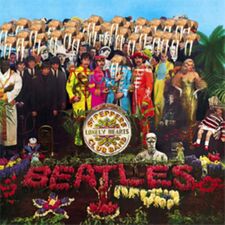
On 9 November 1966, John met a Japanese avant-gartist named Yoko Ono at a cheap art show, and they decided to get married straight away. At first, Yoko contributed to an altogether sense of togetherness between the members of the band, but she would soon lead to the band breaking up. Also coincidentally (or not?) on that day, McCartney, after an argument during a Beatles' recording session, angrily stormed off to a taxi. When the fangirl who was driving the taxi realized who her passenger was, she squealed with joy and crashed the vehicle, injuring McCartney.
Thanks to the Beatles' immense popularity, this relatively minor incident ballooned rather quickly. Informal polls showed that in winter 1966, many fans were convinced that The Beatles had replaced Paul with William "Billy" Shears Campbell, the winner of a McCartney look-alike contest. Others accused John Lennon of hijacking an RAF fighter and crashing it into Paul's taxi in the hopes of taking his co-lead singer status in the band. Despite all this silly business, Paul was alive, and the controversy quickly subsided. It would return in a few years, however.
Not having to tour allowed The Beatles more time for other...uh, recreational activities, such as growing mustaches. These "activities" were vital in crafting the music of their 1967 album, Sgt. Pepper's Lonely Hearts Club Band, about the one and only Billy Shears and his lonely hearts. This album was the first ever example of a "concept album" that contained "songs". Unfortunately, the material binding the concept together was not particularly strong. Lennon's song, "Good Morning Good Morning", was a load of slapped-together nonsense about how the world ended when he smoked a Woodbine going to school. McCartney's song, "When I'm 64", was a chintzy popped-up nursery rhyme. George's song, "Within You, Without You", was Bollywood fluff that only he seemed to like. And Ringo couldn't think of anything at all.
To make matters worse, "Penny Cleo Lane" and "Strawberry Fields Forever", widely considered two of the best songs from the sessions, were released as singles and not included on the album. Luckily, McCartney decided to stop writing granny shit and banged out two great songs: the title track and "A Day in the Life". The album was bookended by these songs in order to give the illusion that it was "the greatest album ever", and not just "a pretty great album". Lennon also suggested McCartney do a reprise of the title track near the end to make the album "sound more conceptual", and so he did.
And so here it was, Sgt. Pepper's Only Hearts Club Bandana. A marvel of production, the best-selling album of all-time, ranked #1 by Rolling Stone—yet as some argued, overrated and not as consistent as Rubber Soul or Revolver. Still, The Beatles were at the top of their game, standing on the edge of a cliff, staring down into the abyss that was and still is...
Fame.
Tragical Mystery Tour, The Blank Album, and Yellow Submarine
In August 1967, The Beatles visited the Maharishi Man, the founder of Transcendental Meditation (TM)TM, in Wales. However, the meeting was quickly cut short by tragic news that their manager, Brian Einstein, had passed away. This tragedy was echoed in their November album Tragical Mystery Tour. Under the illusion that drugs made them good songwriters, The Beatles spent months binging out on anything they could find, from the slimmest blunt to the biggest rock. Surprisingly, the resulting album was quite good; perhaps one of their best. The accompanying TV movie, however, was dismal, consisting mostly of The Beatles pulling pranks and being smartasses mixed in with psychedelic landscape shots.
In February 1968, the Beatles met with the Maharishi again, this time in his native India. The Maharishi was the head leader of an Indian tea/curry meditation association of hypnosis. However, the meeting was again cut short due to the Maharishi having allegations of sexual harassment from his female students. The good news is that the tea wasn't that bad, and the curry was absolutely fantastic. But the Gulab Jamun gave Ringo something bad. That's what you get for eating something you can't pronounce.
In July 1968 the band released another trippy movie, Yellow Submarine, based on Ringo's nursery rhyme song from Revolver. Critics expected another Mystery Tour Tragedy, but were instead delighted by film's phantasmagoric visuals and hidden Vietnam War subtext. During this time, it became clear to The Beatles that fame was going to their heads. They had to squeeze out some remaining good material before they jumped the shark. In November 1968, they released a double-album boldly titled The Beatles, or The White Album. Unlike every Beatles album before, The Blank Album contained hundreds of songs, each of wildly varying quality. These songs were written during their India trip, and were inspired by their LSD trips while there.
The release of The White Album was met with rave reviews, until Charles Manson and his cult of super-meanies got their dirty little hands on the album and a bongful of ether, producing a prophecy foretelling a war between white people and black people. Many years later, The Black Album was released by Metallica, later by Jay-Z, and even later by Weezer — implying to some conspiracy theorists that either cool black people or nerdy white people will win the race war.
Around this time, The Beatles, tired of being shafted by greedy executives, decided to abandon their record label Parlophone and form their own label called Apple Cores (not to be confused with Apple Inc.). It founded upon ideals that would attract young, untarnished talent to the industry so at last they could be the ones doing the shafting instead, though only for tax purposes.
Get Back, Abbey Road, "Everyone But Paul Is Dead", Let It Be, and breakup
By this point, The Beatles had finished their gradual metamorphosis from four dynamic and creative friends from Liverpool into feuding, greedy businessmen with overblown egos. They were always the kind to get into arguments, but they began to bicker more often after Epstein's death. Brian kept them together by giving them good advice, a nice cold beer, and the occasional ego-stroking. Without these fine essentials being given to them, The Beatles became increasingly crankish.
Tensions also ramped up between John and the rest of the band. John had become increasingly obsessed with his wife Yoko, and even got her to sing on one track of The White Album, much to the band's dismay. The other three Beatles stopped doing drugs and realized that Yoko was irritating, and wanted her to stop attending recording sessions, but John didn't listen.
In January 1969, The Beatles began work on their next album, Get Back. John was arrested for possession of heroin, and was replaced by a black guy named Billy Preston who could sure play the organ real funky. The band wrote and recorded several songs for Get Back, including ones John had written while in jail. To promote the album, The Beatles got to the studio's roof for their famous Rooftop Concert, their final live performance. The concert went on for about an hour before some idiots on the opposite side of town from the studio filed noise complaints to the police, who eventually found the band performing on the rooftop and arrested them.
On 22 February, The Beatles were released from jail. The Get Lost sessions had left an awful taste in their mouths, so they shelved the album to work on a better one titled Abbey Road. Yoko no longer attended recording sessions; Paul, George, and Ringo were relieved. In September, after a nasty fight with the rest of the band, Lennon parted ways with The Beatles and ran off with Yoko to record their own album under the name The Polyurethane Oh No Ono Band. Finally, in December, Abbey Road was released to rave reviews.
That month, a fateful telephone call was made to an obscure Minneapolis radio station. A scientist informed shocked DJs that a subliminal message in the group's albums revealed that everyone but Paul is dead. Earlier everybody thought Paul was the one dead. The news sent shockwaves through the world music community. Everybody was very confused.
Ringo was the first to go, because in 1963, on the cover of Without the Beatles, Ringo's face is clearly not in line with those of his fabulous bandmates. On the cover of A Hard Day's Night, George is the only one with his back to the camera in any of the pictures, and he's the only one holding a cigarette. On the cover of the Yelp! album, the Beatles hold their arms in semaphore positions, but rather than spelling Y-E-L-P as one might expect, it spells H-E-L-P? That meant an untimely death had befallen John and he had been replaced. In "I'm Looking Through You", Paul sings of the state of his friends and coworkers: "You don't look different, but you have changed...You don't sound different, I've learned the game/I'm looking through you, you're not the same."
Post-Sgt. Pepper albums distinguish Paul as the only surviving original member. One of the many figures on the cover of that album holds a hand over Paul's head, as if to bless him, and on the reverse, he is shown with his back to the camera. All Beatles fans were actually brainwashed into believing Paul was dead, but the scientist showed proof, all was finally understood. Then another scientist examined these claims and discovered that it was all a hoax.
The Sixties were over. A whole new decade of possibilities was opened up to The Beatles, but the high level of bickering at the time implied that the band unity would not survive the Seventies. In order to distract the listeners from the ending of the oeuvre long enough to squeeze just a little more cash out of the brand, manager Allen Klein forced the group to continue work on Get Back, now titled Let It Be. The Threetles — now sans Lennon — were ready to record another album, but they couldn't conceptualize anything, plus they were quite bored with each other. So they recorded the song "I Me Mine", did a few overdubs on "Let It Be", and that was it.
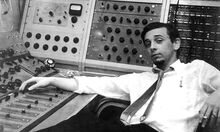
In March 1970, behind the other Beatles' backs, Lennon hired noted murderer producer Phil Spector to finish Let It Be. This resulted in the album having a frilly, lush, overproduced '70s sound — particularly the lead single "The Long and Winding Road" — rather than the rootsy blues feel it was supposed to have. Upset that his own friend would destroy a song he wrote, McCartney announced the breakup of The Beatles in April. He went on to pursue a solo career; John wrote more stupid albums with Yoko; Ringo, feeling squeamish and needing some mental flushing, went to Switzerland to relax for a year or two; and George went back to India to fade into obscurity. The album Let It Be was released in May, accompanied by a movie of the same name that grossed $500.
The Beatles, the band that had helped the whole nation pull together after the tragic death of JFK, and also defined a generation with their hippiedom, were no more. The dream was over.
Post-Breakup
1970s
After going their separate ways, The Beatles could not wait to record all of the songs they had written in the 1960s but never got the chance to record.
John remained in The Polyurethane Band until 1973, and didn't release a solo album until 1971. In 1974, after recording an album with Paul, John got into a fight with Yoko, and they broke up for a year, during which John dated some other annoying Asian chick and made an album whose central theme was dreams. In 1975, John and Yoko were reunited, and they made one more album before settling down to raise a family in New York City. From 1975 to 1979, John and Yoko kept to themselves. John decided to write a musical, and recorded demos of the songs he wrote for the musical.
Paul made his first solo album in 1970. In 1971, Paul formed the hot new band Wings. In 1974, Paul recorded an album with John; it was never released. In 1975, Wings broke up, and Paul settled down in Scotland, making a new album every year or so.
George returned from his pilgrimage in 1971, claiming to be "changed". He never talked about any personal developments, he just said he was "changed". Although George had thousands of songs to record, he did not find himself very defined as a solo artist, so he just joined The Polyurethane Band and played guitar on some of John's songs until he finally found inspiration and began his solo career. In 1977, George was finally ready to start recording, but he was immediately distracted by the new movie Star Wars, then got involved in the production of Monty Python's Life of Brian. George did not make any solo albums in the 1970s.
Ringo was relieved of all stress by 1972, when he returned to England and made his first solo album, which sucked. In 1973, Ringo made another album, which sucked less. Throughout the 1970s, Ringo made more albums with increasing quality and decreasing sales.
1980s
The 1980s were quite pivotal for The Beatles, quite pivotal indeed.
It all started in January 1980. John was excited for the 1980s. He was ready for another chance at success now that he had finsished writing his musical, but he decided to shelve it until he got enough money to put it on Broadway. And what better way to get a shitload of money really fast than to make an album? It had been five years since he made his last album, and he was finally ready to make another one. Of course, Yoko joined. This new album, titled Double Vision, was released in November. At first, everybody hated it, but then Barney (not Mark Chapman) killed John three years later — so everybody loved it.
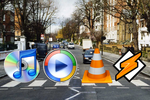
1990s
In the 1990s, The Beatles reformed. Unfortunately, John could not attend recording sessions, being obviously dead and all, but the three living Beatles tried many methods of bringing him back, if only briefly. They could not summon him as a zombie, as his body had been cremated. They performed a seance to summon his ghost, bearing no answer. As a last resort, as they simply could not play without John, they politely asked Yoko for the demos John recorded in the Seventies. Yoko gave them the tapes and trusted them with them. Paul, George, and Ringo put the tapes to decent use, recording fully-instrumented versions of the songs "Free FREE Free" and "Limerence". These tracks were later included in the Anthology albums.
2000s
The new millenium saw George with serious problems. He was stabbed in the face by one of our historians, who had DOI in his system at the time. George had been diagnosed with throat cancer from smoking too much weed, and after the attack, he also had brain cancer. This eventually killed him.
2010s
As it happens, Ringo doesn't do anything anymore. Paul does too many things.
2020s
Paul keeps doing too many things. Ringo does a few. John and George are still dead.
Did You Know?
- Ringo Starr was the only Beatle to have a double chin. The other Beatles didn't eat. The last time McCartney ate was in 1958 when he had a fish, hence the famous song "Can't Buy Me Cod".
- Recent statistical analysis by an MIT PhD reveals that at one point in 1966 The Beatles actually were more popular than Jesus, by 43%.
- All of the Beatles music was influenced by the little known North Manchesterford combo called Oasis. 'Without Oasis, there would be no Beatles' Paul was once overheard saying in a haze.
- George was the son of a certain Hairy Harry, who was the son of Harry's son.
- Lennon’s real name was Johnny Bender, which he changed after going on holiday to Spain with manager Brian Epstein, as people might have got the wrong impression.
- The 'Walrus' was actually Starr. This was a great insult to walruses.
- Two Beatles haven't been stabbed or shot, even though Heather Mills tried her best.
- The Beatles were a leading force in the British Colonization of Black Music, in which blacks were enslaved and forced to give up the 12-bar blues and instead write artsy "pop-rock" songs for white men (such as The Beatles) for little or no money.
- Bob Dylan was introduced to hard drugs by The Beatles, and has never looked back in anger, preferring instead to get stoned with EVERYBODY, by force if necessary.
- Ringo Starr was replaced by an orangutan from 1963 to 1968. Nobody noticed. They were busy looking at John to see if it really was John... or a walrus. No one knows for sure.
- In Soviet Russia, The Beatles first single to be released was called, "Healthy Soviet Hand Wants to Hold You!"
- On the picture where The Beatles were walking down Abbey Road, Paul McCartney wasn't out of step, John George and Ringo were.
- The Beatles never went to Soviet Russia twice, hence the song "Back in the U.S.S.R." is just another clue to Paul being dead.
- The death metal band Necro-Deth Cannibals from Hell claims that The Beatles were one of their greatest influences.
See also
- The Beatles: John Needs Your Help
- Rubber Paul
- History of The Beatles, another viewpoint
- Love (album)
| |||||||||||||||||||


